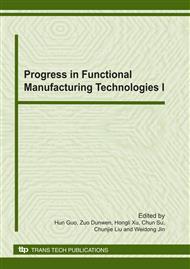p.295
p.301
p.307
p.313
p.319
p.325
p.331
p.337
p.344
Simulation Study of the Temperature Field for Squashed Presetting Laser Cladding Based on ANSYS
Abstract:
In the process of modeling the squashed piece of powders for the simulation of the temperature field of laser cladding, the metallurgical model and the pore model were proposed separately. The effects of the organizational form, the contact resistance and the thickness of the squashed piece of powders on the temperature were considered. Different values of physical parameters of the squashed piece of powders were converted, different contact resistances were calculated and the laser absorptivity for different process parameters of laser cladding was determined. The temperature curves of six typical nodes and the temperature gradient of two nodes in the molten pool of the substrate were discussed from different aspects.
Info:
Periodical:
Pages:
319-324
Citation:
Online since:
December 2010
Authors:
Price:
Сopyright:
© 2011 Trans Tech Publications Ltd. All Rights Reserved
Share:
Citation:


